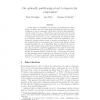Free Online Productivity Tools
i2Speak
i2Symbol
i2OCR
iTex2Img
iWeb2Print
iWeb2Shot
i2Type
iPdf2Split
iPdf2Merge
i2Bopomofo
i2Arabic
i2Style
i2Image
i2PDF
iLatex2Rtf
Sci2ools
ESA
2009
Springer
2009
Springer
On Optimally Partitioning a Text to Improve Its Compression
In this paper we investigate the problem of partitioning an input string T in such a way that compressing individually its parts via a basecompressor C gets a compressed output that is shorter than applying C over the entire T at once. This problem was introduced in [2, 3] in the context of table compression, and then further elaborated and extended to strings and trees by [10, 11, 21]. Unfortunately, the literature offers poor solutions: namely, we know either a cubic-time algorithm for computing the optimal partition based on dynamic programming [3, 15], or few heuristics that do not guarantee any bounds on the efficacy of their computed partition [2, 3], or algorithms that are efficient but work in some specific scenarios (such as the Burrows-Wheeler Transform, see e.g. [10, 21]) and achieve compression performance that might be worse than the optimal-partitioning by a Ω( √ log n) factor. Therefore, computing efficiently the optimal solution is still open [4]. In this paper ...
Algorithm | Algorithms | Compressed Output | ESA 2009 | Input String |
Related Content
| Added | 26 May 2010 |
| Updated | 26 May 2010 |
| Type | Conference |
| Year | 2009 |
| Where | ESA |
| Authors | Paolo Ferragina, Igor Nitto, Rossano Venturini |
Comments (0)

